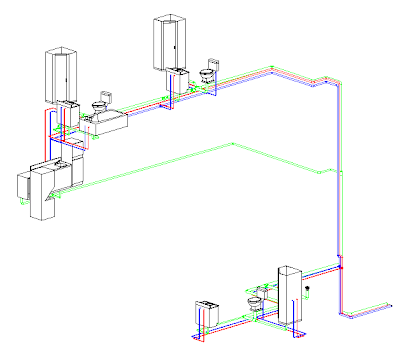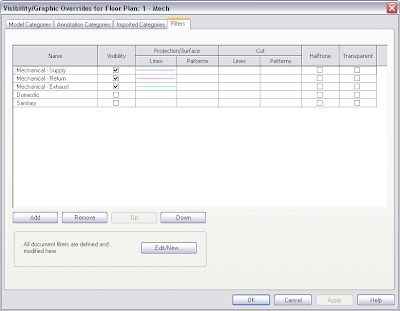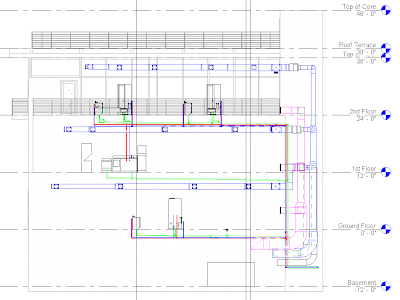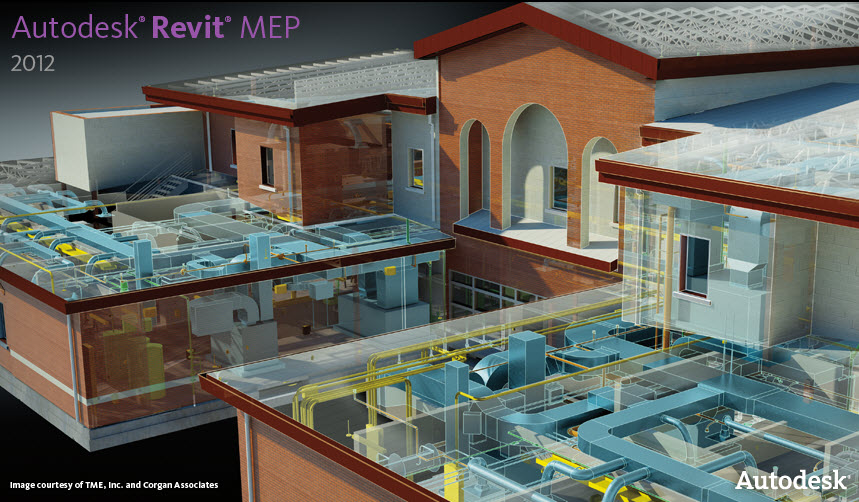A White Paper from Autodesk
Introduction to Building Information ModelingBuilding information modeling—an innovative new approach to building design, construction, has changed the way industry professionals worldwide think about how technology can be applied to building design, construction, and management.
Building information modeling supports the continuous and immediate availability of project design scope, schedule, and cost information that is high quality, reliable, integrated, and fully coordinated. Among the many competitive advantages it confers are:
- Increased speed of delivery (time saved)
- Better coordination (fewer errors)
- Decreased costs (money saved)
- Greater productivity
- Higher-quality work
- New revenue and business opportunities
For each of the three major phases in the building lifecycle—design, construction, and management—building information modeling offers access to the following critical information:
- In the design phase—design, schedule, and budget information
- In the construction phase—quality, schedule, and cost information
- In the management phase—performance, utilization, and financial information
The ability to keep this information up to date and accessible in an integrated digital environment gives architects, engineers, builders, and owners a clear overall vision of their projects, as well as the ability to make better decisions faster—raising the quality and increasing the profitability of projects.
Although building information modeling is an approach and not a technology, it does require suitable technology to be implemented effectively. Examples of some of these technologies, in increasing order of effectiveness, include:
- CAD
- Object CAD
- Parametric Building Modeling
This paper will describe what building information modeling is, how it confers competitive advantages, and how it can be achieved using a flexible range of technologies.
What Is Building Information Modeling, and What Are Its Key Benefits?
Building information modeling is an approach to building design, construction, and management. It supports the continuous and immediate availability of project design scope, schedule, and cost information that is high quality, reliable, integrated, and fully coordinated. Though it is not itself a technology, it is supported to varying degrees by different technologies.
Building information modeling is, essentially, the intersection of two critical ideas:
- Keeping critical design information in digital form makes it easier to update and share and more valuable to the firms creating and using it.
- Creating real-time, consistent relationships between digital design data—with innovative parametric building modeling technology—can save significant amounts of time and money and increase project productivity and quality.
What follows is a more detailed look at how building information modeling works, as well as the benefits it offers in the design, construction, and management phases of the building lifecycle.
Building Information Modeling Benefits in the Design PhaseDuring the course of a building project, an architect must balance the project scope, schedule, and cost. Using building information modeling techniques, all of this critical information is immediately available, so that project-related decisions can be made more quickly and effectively.
Building information modeling allows a project team to make changes to the project at any time during the design or documentation process without laborious, low-value recoordination and manual checking work. This gives the team more time to work on design and other high-value architectural problems. In addition, all of the building design and documentation work can be done concurrently instead of serially, because design thinking is captured at the point of creation and embedded in the documentation as the work proceeds.
Whenever a change is made to a project, all the consequences of that change are automatically coordinated throughout the project. The automatic coordination of changes offered by building information modeling eliminates coordination mistakes, improves the overall quality of the work, and helps companies win more repeat business.
Building Information Modeling Benefits in the Construction PhaseIn the construction phase of the building lifecycle, building information modeling makes available concurrent information on building quality, schedule, and cost. The builder can accelerate the quantification of the building for estimating and value-engineering purposes and for the production of updated estimates and construction planning. The end result is that more of the owner’s construction dollar goes into the building than into administrative and overhead costs.
Building Information Modeling Benefits in the Management PhaseIn the management phase of the building lifecycle, building information modeling makes available concurrent information on the use or performance of the building; its occupants and contents; the life of the building over time; and the financial aspects of the building. Building information modeling provides a digital record of renovations and improves move planning and management. Physical information about the building, such as finishes, tenant or department assignments, furniture and equipment inventory, and financially important data about leasable areas and rental income or departmental cost allocations are all more easily managed and available. Consistent access to these types of information improves both revenue and cost management in the operation of the building.
Potential for New Services and Revenue SourcesWhen building information modeling is used effectively, architects can make use of a project's digital design data to provide new services and gain new sources of income. Owners are increasingly demanding digital models, and paying for them. Architects can also offer new and expanded services—such as move management, energy analysis, digitally integrated cost estimating, and renovation phase planning—for additional fees.
What Technologies Can Be Used to Implement Building Information Modeling?Although building information modeling is an approach and not a technology, it does require suitable technology to be implemented effectively. Examples of some of these technologies, in increasing order of effectiveness, include
- CAD
- Object CAD
- Parametric building modeling
CAD TechnologyThe gray line in the chart represents CAD-based software; that is, software that is based on the familiar geometry-based CAD technology used in the industry for several decades. This technology supports drafting automation very effectively and with little effort. However, to achieve increasing levels of efficiency, this technology requires greater and greater levels of effort. Higher levels of administrative and management overhead are introduced, layer and naming standards must be maintained and enforced, and the quality of the information coming from the CAD-based files depends heavily on the discipline and reliability of the users entering the data. Very high levels of effort, including programming and partner product development, can achieve effectiveness in the building information modeling range. However, the level of effort required is so high that CAD-based technology is rarely used at this level.
Object CAD TechnologyObject CAD seeks to simulate building components in a CAD-based environment, focusing on the 3D geometry of the building, the generation of 2D documentation from that 3D geometry, and the extraction of object data from the building components to provide information about quantities and object properties. This technology can be applied very effectively to help coordinate the various representations of the building in documentation, and because it carries rich data about the building in the object structure, it can also be extended into building information modeling.
Object CAD technology also allows for great variety in levels of use, and because it is based on CAD, it can be particularly easy to implement—and often yields immediate benefits—with little or no process change. However its effectiveness remains contingent on user discipline and reliability, and it cannot ensure the presence of the high-quality, reliable, integrated, and fully coordinated information required for the highest levels of building information modeling benefits.
Parametric Building Modeling TechnologyParametric building modeling combine a data model (geometry and data) with a behavioral model (change management) that gives meaning to the data through relationships. This provides an integrated system that can be used to simulate the behavior of a real-world system—in this case, a building. Examples of the most advanced features of this kind of system are real-time self-coordination of the information in every view, and the assurance of the quality of the information coming from the system.
Some other important characteristics of software based on parametric building modeling technology include:
- Information about the entire building and a complete set of design documents are stored in an integrated database. All of the information is parametric and therefore completely interconnected.
- Any change to the relationships among objects is always instantly reflected throughout the rest of the project—in all representations of the project.
- All relationships within the model are available for user definition—not just relationships (such as a window hosted by a wall) that have been preprogrammed by the developers. This includes graphical definition by the end user of parametric objects.
Just as a spreadsheet is a tool for thinking about numbers, software built on parametric building modeling technology is a tool for thinking about buildings. And just as a change made anywhere in a spreadsheet is expected to update everywhere with no further intervention from the user, so a change made anywhere in a parametric building modeler is immediately reflected everywhere.
Only a purpose-built integrated data architecture built around a parametric building model can provide the immediate and fully coordinated representation of a project across all views, drawing sheets and schedules that is necessary to eliminate errors and provide clarity and confidence in decision making.
Autodesk offers products based on all three building design and documentation technologies, and fully understands the pros and cons of each. Parametric building modeling technology is uniquely suited to supporting the highest level of building information modeling effectiveness at the lowest level of effort. Parametric building modeling uniquely offers the concurrent and immediate availability of all of the important information about the building that results in higher quality work, greater speed and productivity, and decreased costs. However, this technology requires the wholesale adoption of building information modeling to put it to use. There is no way to use this technology in a traditional, non-building information modeling environment. Using this technology can deliver tremendous business benefits, but doing so requires a departure from traditional ways of working. Moving from CAD-based technology to object CAD technology can be an incremental or evolutionary change, but moving to parametric building modeling technology for building information modeling requires a new way of working.

 Line Styles by Pipe Type
Line Styles by Pipe Type 1. Settings -> Filters... Here you define the Filters that will exist in the project.
1. Settings -> Filters... Here you define the Filters that will exist in the project. 2. Select a view in the Project Browser that you want to apply these filters on, go to Properties -> Visibility Graphics Overrides... -> Filters tab. Here you will select a filter you defined in step 1 and define visual overrides for elements that are returned by the filter.
2. Select a view in the Project Browser that you want to apply these filters on, go to Properties -> Visibility Graphics Overrides... -> Filters tab. Here you will select a filter you defined in step 1 and define visual overrides for elements that are returned by the filter. 3. Go to that view, note that your Filters have been applied and there is a visual difference between your systems.
3. Go to that view, note that your Filters have been applied and there is a visual difference between your systems.
